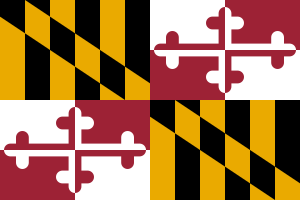
Back Histoire du Maryland French Մերիլենդի պատմություն Armenian メリーランド州の歴史 Japanese История Мэриленда Russian

The recorded history of Maryland dates back to the beginning of European exploration, starting with the Venetian John Cabot, who explored the coast of North America for the Kingdom of England in 1498. After European settlements had been made to the south and north, the colonial Province of Maryland was granted by King Charles I to Sir George Calvert (1579–1632), his former Secretary of State in 1632, for settlement beginning in March 1634. It was notable for having been established with religious freedom for Roman Catholics, since Calvert had publicly converted to that faith.[1][2][3] Like other colonies and settlements of the Chesapeake Bay region, its economy was soon based on tobacco as a commodity crop, highly prized among the English, cultivated primarily by African slave labor, although many young people came from Britain sent as indentured servants or criminal prisoners in the early years.
In 1781, during the American Revolutionary War (1775–1783), Maryland became the seventh state of the United States to ratify the Articles of Confederation and Perpetual Union. They were drawn up by a committee of the Second Continental Congress (1775–1781), which began shortly after the adoption of a Declaration of Independence in July 1776, to 1778. Later that year, these articles were recommended to the newly independent sovereign states via their legislatures for the required unanimous ratification. This long process was held up for three years by objections from smaller states led by Maryland until certain issues and principles over the western lands beyond the Appalachian Mountains to the Mississippi River. These objections were resolved with the larger states agreeing to cede their various western claims to the authority of the new Congress of the Confederation, representing all the states, to be held in common for the laying out and erection of new states out of the jointly held federal territories. Maryland then finally agreed to join the new American confederation by being one of the last of the former colonies ratifying the long proposed Articles in 1781, when they took effect. Later that same decade, Maryland became the seventh state to ratify the stronger government structure proposed in the new U.S. Constitution in 1788.
After the Revolutionary War, numerous Maryland planters freed their slaves as the economy changed. Baltimore grew to become one of the largest cities on the eastern seaboard, and a major economic force in the country. Although Maryland was still a slave state in 1860, by that time nearly half of the African American population was free, due mostly to manumissions after the American Revolution.[4] Baltimore had the highest number of free people of color of any city in the United States. Maryland was among the four divided border states during the American Civil War (1861–1865), with most Marylanders fighting for the Union Army, along with a large number for the Confederacy. As a border state, it officially remained in the Union throughout the war.
- ^ Greenwell, Megan. "Religious Freedom Byway Would Recognize Maryland's Historic Role", Washington Post, August 21, 2008.
- ^ Calvert, Cecilius. "Instructions to the Colonists by Lord Baltimore, (1633)", Narratives of Early Maryland, 1633–1684 (Clayton Coleman Hall, ed.), (NY: Charles Scribner's Sons, 1910), 11–23.
- ^ "Reconstructing the Brick Chapel of 1667" (PDF). p. 1. Archived from the original (PDF) on March 13, 2014. Retrieved December 10, 2015.
- ^ Kolchin, Peter. American Slavery: 1619–1877, New York: Hill and Wang, 1993, pp. 81–82
© MMXXIII Rich X Search. We shall prevail. All rights reserved. Rich X Search